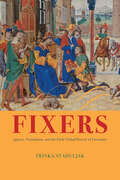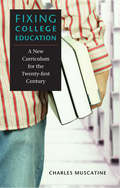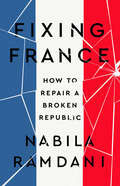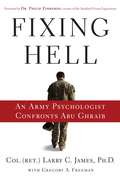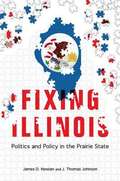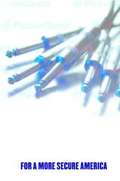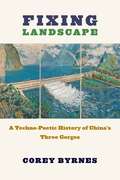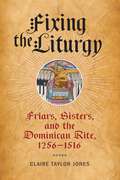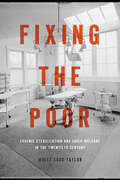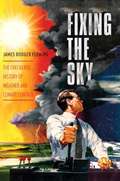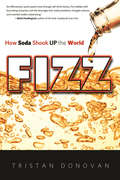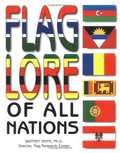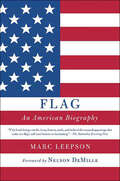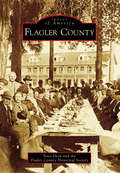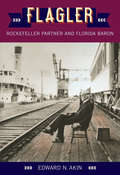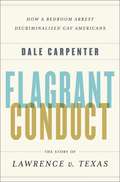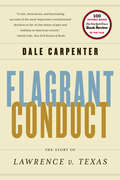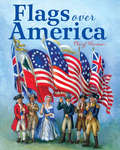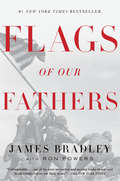- Table View
- List View
Fixers: Agency, Translation, and the Early Global History of Literature
by Zrinka StahuljakA new history of early global literature that treats translators as active agents mediating cultures. In this book, Zrinka Stahuljak challenges scholars in both medieval and translation studies to rethink how ideas and texts circulated in the medieval world. Whereas many view translators as mere conduits of authorial intention, Stahuljak proposes a new perspective rooted in a term from journalism: the fixer. With this language, Stahuljak captures the diverse, active roles medieval translators and interpreters played as mediators of entire cultures—insider informants, local guides, knowledge brokers, art distributors, and political players. Fixers offers nothing less than a new history of literature, art, translation, and social exchange from the perspective not of the author or state but of the fixer.
Fixing College Education: A New Curriculum for the Twenty-first Century
by Charles MuscatineSince his early days at the University of California, Berkeley, when he was fired for refusing to sign a loyalty oath during the Red Scare, Charles Muscatine has been a dedicated teacher and higher education reformer. Upon his reinstatement at Berkeley, he founded "Strawberry Creek College," a six-year experiment using full professors and small classes to teach lower-division students. Drawing on this belief in undergraduate teaching, Muscatine's new book now offers a radical new design for American college education.Muscatine begins with the observation that the mediocre undergraduate curriculum offered by most colleges and universities today is based on outdated ideas of what should be taught and what constitutes good teaching. Although Muscatine is himself a well-established research scholar, he contends that the publish-or-perish "research religion" of college and university faculties has seriously damaged undergraduate education. He offers a clear distinction between publishable research and the scholarship necessary for good teaching. Furthermore, he recommends major changes in the education of professors, including reconsidering both the requirement of the book-length dissertation and the current organization of graduate departments. Fixing College Education predicts new roles for students and faculty, redefines educational breadth and depth, and calls for deeper assessment of learning and teaching. Muscatine highlights the outstanding colleges and universities, including Harvard, Boston University's University Professor's Program, Evergreen State College, and Fairhaven College at Western Washington University, that have already remade their curricula successfully or adopted features like the ones he proposes. Muscatine argues that the new curriculum is better able than the old to produce good scholars and good citizens for the twenty-first century.
Fixing Drugs
by Sue PryceIn this unique and engaging book, Sue Pryce tackles the major issues surrounding drug policy. Why do governments persist with prohibition policies, despite their proven inefficacy? Why are some drugs criminalized, and some not? And why does society care about drug use at all? Pryce guides us through drug policy around the world.
Fixing English
by Anne CurzanOver the past 300 years, attempts have been made to prescribe how we should and should not use the English language. The efforts have been institutionalized in places such as usage guides, dictionaries, and school curricula. Such authorities have aspired to 'fix' the language, sometimes by keeping English exactly where it is, but also by trying to improve the current state of the language. Anne Curzan demonstrates the important role prescriptivism plays in the history of the English language, as a sociolinguistic factor in language change and as a vital meta-discourse about language. Starting with a pioneering new definition of prescriptivism as a linguistic phenomenon, she highlights the significant role played by Microsoft's grammar checker, debates about 'real words', non-sexist language reform, and efforts to reappropriate stigmatized terms. Essential reading for anyone interested in the regulation of language, the book is a fascinating re-examination of how we tell language history.
Fixing France: How to Repair a Broken Republic
by Nabila RamdaniA French-Algerian journalist, born and brought up in a neglected Paris suburb, offers unique insight into crisis-ridden France from a very different perspective to the establishment elites France, the romanticized, revolutionary land with an enlightened historical mission—Liberty, Equality, Fraternity for all—is failing its own citizens and its admirers around the world. How did the country get here, and what can be done about it? In Fixing France, Nabila Ramdani assesses the fault lines in her struggling nation with unflinching clarity and originality. The makeshift Fifth Republic, which emerged from the cataclysmic Algerian War of Independence, has produced extremism. Constitutional reform is urgently needed: an all-powerful monarchical president displays little interest in democracy, while a mainstream far-right party founded by Nazi collaborators threatens to deliver a head of state. Segregated suburbs, institutionalized rioting, economic injustice, a monolithic education system, the debasement of women, deep-seated racial and religious discrimination, paramilitary policing, terrorism, and a duplicitous foreign policy all fuel the growing crisis. Ramdani&’s critique is stark but provides real hope: the broken French Republic can and must be fixed.
Fixing Hell: An Army Psychologist Confronts Abu Ghraib
by Gregory A. Freeman Larry C. JamesThis is the story of Abu Ghraib that you haven't heard, told by the soldier sent by the Army to restore order and ensure that the abuses that took place there never happen again.In April 2004, the world was shocked by the brutal pictures of beatings, dog attacks, sex acts, and the torture of prisoners held at Abu Ghraib in Iraq. As the story broke, and the world began to learn about the extent of the horrors that occurred there, the U.S. Army dispatched Colonel Larry James to Abu Ghraib with an overwhelming assignment: to dissect this catastrophe, fix it, and prevent it from being repeated. A veteran of deployments to Guantanamo Bay, Cuba, and a nationally well-known and respected Army psychologist, Colonel James's expertise made him the one individual capable of taking on this enormous task. Through Colonel James's own experience on the ground, readers will see the tightrope military personnel must walk while fighting in the still new battlefield of the war on terror, the challenge of serving as both a doctor/healer and combatant soldier, and what can-and must-be done to ensure that interrogations are safe, moral, and effective.
Fixing Illinois: Politics and Policy in the Prairie State
by James D. Nowlan J. Thomas JohnsonPersistent problems have left Illinois the butt of jokes and threatened it with fiscal catastrophe. In Fixing Illinois, James D. Nowlan and J. Thomas Johnson use their four decades of experience as public servants, Springfield veterans, and government observers to present a comprehensive program of almost one hundred specific policy ideas aimed at rescuing the state from its long list of problems. Nowlan and Johnson start with the history of how one of the most prosperous states of the 1950s became a present-day mess riven by debt and discord and increasingly abandoned by both businesses and citizens. Among their more than ninety proposals to restore Illinois to greatness: * An overhaul of state pension systems that includes more reasonable benefits and lengthening of the retirement age, among other changes; * Reducing one of the nation's highest corporate tax rates to attract business; * Medicare reform through an insurance voucher program; * Demanding that schools raise expectations for success, particularly in rural and impoverished urban areas; * A new approach to higher education that includes a market-driven system that puts funds in the hands of students rather than institutions; * Broadening of the tax base to include services and reduction in rates; * The creation of a long-term plan to maintain the state's five-star transportation infrastructure; * Raising funds with capital construction bonds to update and integrate the antiquated information systems used by state agencies; * Uprooting the state's entrenched culture of corruption via public financing of elections, redistricting reform, and revolving door prohibitions for lawmakers. Pointed, honest, and pragmatic, Fixing Illinois is a plan for effective and honest government that seeks an even nobler end: restoring our faith in Illinois's institutions and reviving a sense of citizenship and state pride.
Fixing Intelligence: For a More Secure America
by William E. OdomBasing his text in large part on a study he authored in 1997, published by the National Institute of Public Policy, Odom (a senior fellow at the Hudson Institute and a former director of the National Security Agency) considers recommendations for the reform of American intelligence activities and organization. Among his suggestions are granting more intelligence oversight authority over all the diverse intelligence organizations to the Director of Central Intelligence; eliminating CIA obstructionism in expanding military intelligence capabilities; recognizing the need to have national managers for the separate disciplines of signals, imagery, and human intelligence; and taking counterintelligence activities out from under the provenance of the law enforcement agencies. Annotation ©2004 Book News, Inc. , Portland, OR (booknews. com)
Fixing Landscape: A Techno-Poetic History of China’s Three Gorges (Studies of the Weatherhead East Asian Institute, Columbia University)
by Corey ByrnesIn 1994, workers broke ground on China’s Three Gorges Dam. By its completion in 2012, the dam had transformed the ecology of the Yangzi River, displaced over a million people, and forever altered a landscape immortalized in centuries of literature and art. The controversial history of the dam is well known; what this book uncovers are its unexpected connections to the cultural traditions it seems to sever. By reconsidering the dam in relation to the aesthetic history of the Three Gorges region over more than two millennia, Fixing Landscape offers radically new ways of thinking about cultural and spatial production in contemporary China.Corey Byrnes argues that this monumental feat of engineering can only be understood by confronting its status as a techno-poetic act, a form of landscaping indebted to both the technical knowledge of engineers and to the poetic legacies of the Gorges as cultural site. Synthesizing methods drawn from premodern, modern, and contemporary Chinese studies, as well as from critical geography, art history, and the environmental humanities, Byrnes offers innovative readings of eighth-century poetry, paintings from the twelfth through twenty-first centuries, contemporary film, nineteenth-century British travelogues, and Chinese and Western maps, among other sources. Fixing Landscape shows that premodern poetry and visual art have something urgent to tell us about a contemporary experiment in spatial production. Poems and paintings may not build dams, but Byrnes argues that the Three Gorges Dam would not exist as we know it without them.
Fixing the Facts: National Security and the Politics of Intelligence
by Joshua RovnerWhat is the role of intelligence agencies in strategy and policy? How do policymakers use (or misuse) intelligence estimates? When do intelligence-policy relations work best? How do intelligence-policy failures influence threat assessment, military strategy, and foreign policy? These questions are at the heart of recent national security controversies, including the 9/11 attacks and the war in Iraq. In both cases the relationship between intelligence and policy broke down-with disastrous consequences. In Fixing the Facts, Joshua Rovner explores the complex interaction between intelligence and policy and shines a spotlight on the problem of politicization. Major episodes in the history of American foreign policy have been closely tied to the manipulation of intelligence estimates. Rovner describes how the Johnson administration dealt with the intelligence community during the Vietnam War; how President Nixon and President Ford politicized estimates on the Soviet Union; and how pressure from the George W. Bush administration contributed to flawed intelligence on Iraq. He also compares the U.S. case with the British experience between 1998 and 2003, and demonstrates that high-profile government inquiries in both countries were fundamentally wrong about what happened before the war.
Fixing the Liturgy: Friars, Sisters, and the Dominican Rite, 1256-1516 (The Middle Ages Series)
by Claire Taylor JonesA new history of the medieval Dominican liturgy, from the perspective of women’s communitiesIn Fixing the Liturgy, Claire Taylor Jones opens a window into the daily practice of medieval liturgy, uncovering the astounding breadth of knowledge, the deep expertise, and the critical thinking required just to coordinate each day’s worship. Focusing on the Dominican order, Jones shows how changes in medieval piety and ritual legislation disrupted the fine-tuned system that Dominicans instituted in the thirteenth century. World-historical events, including the Great Western Schism and the expansion of the Ottoman Empire, had an impact on the practice of liturgy even in individual communities. Through a set of never-before-studied records from Dominican convents, Jones shows how women’s communities reacted and adapted to historical change and how their surviving sources inform our understanding of the friars’ lives, as well. Tracing the narrative up to the eve of the Protestant Reformation, this study culminates in a multi-media reconstruction of the sounds, sights, and smells of worship in the rightfully famous southern German convent of St. Katherine in Nuremberg.Fixing the Liturgy makes this late medieval world accessible through clear introductions to medieval liturgy and to the Dominican order’s governance. Jones illustrates how Dominican friars and sisters reconciled their order’s rules with their own concrete circumstances and with the changing world around them. On the way, a new history of the medieval Dominican liturgy unfolds, told from the perspective of women’s communities.
Fixing the Poor: Eugenic Sterilization and Child Welfare in the Twentieth Century
by Molly Ladd-TaylorHow state welfare politics—not just concerns with "race improvement"—led to eugenic sterilization practices.Honorable Mention, 2018 Outstanding Book Award, The Disability History AssociationShortlist, 2019 Wallace K. Ferguson Prize, Canadian Historical AssociationBetween 1907 and 1937, thirty-two states legalized the sterilization of more than 63,000 Americans. In Fixing the Poor, Molly Ladd-Taylor tells the story of these state-run eugenic sterilization programs. She focuses on one such program in Minnesota, where surgical sterilization was legally voluntary and administered within a progressive child welfare system.Tracing Minnesota's eugenics program from its conceptual origins in the 1880s to its official end in the 1970s, Ladd-Taylor argues that state sterilization policies reflected a wider variety of worldviews and political agendas than previously understood. She describes how, after 1920, people endorsed sterilization and its alternative, institutionalization, as the best way to aid dependent children without helping the "undeserving" poor. She also sheds new light on how the policy gained acceptance and why coerced sterilizations persisted long after eugenics lost its prestige. In Ladd-Taylor's provocative study, eugenic sterilization appears less like a deliberate effort to improve the gene pool than a complicated but sadly familiar tale of troubled families, fiscal and administrative politics, and deep-felt cultural attitudes about disability, dependency, sexuality, and gender. Drawing on institutional and medical records, court cases, newspapers, and professional journals, Ladd-Taylor reconstructs the tragic stories of the welfare-dependent, sexually delinquent, and disabled people who were labeled "feebleminded" and targeted for sterilization. She chronicles the routine operation of Minnesota's three-step policy of eugenic commitment, institutionalization, and sterilization in the 1920s and 1930s and shows how surgery became the "price of freedom" from a state institution. Combining innovative political analysis with a compelling social history of those caught up in Minnesota's welfare system, Fixing the Poor is a powerful reinterpretation of eugenic sterilization.
Fixing the Sky
by Fleming James RodgerAs alarm over global warming spreads, a radical idea is gaining momentum. Forget cuts in greenhouse gas emissions, some scientists argue. Instead, bounce sunlight back into space by pumping reflective nanoparticles into the atmosphere. Launch mirrors into orbit around the Earth. Make clouds thicker and brighter to create a "planetary thermostat. "These ideas might sound like science fiction, but in fact they are part of a very old story. For more than a century, scientists, soldiers, and charlatans have tried to manipulate weather and climate, and like them, today's climate engineers wildly exaggerate what is possible. Scarcely considering the political, military, and ethical implications of managing the world's climate, these individuals hatch schemes with potential consequences that far outweigh anything their predecessors might have faced. Showing what can happen when fixing the sky becomes a dangerous experiment in pseudoscience, James Rodger Fleming traces the tragicomic history of the rainmakers, rain fakers, weather warriors, and climate engineers who have been both full of ideas and full of themselves. Weaving together stories from elite science, cutting-edge technology, and popular culture, Fleming examines issues of health and navigation in the 1830s, drought in the 1890s, aircraft safety in the 1930s, and world conflict since the 1940s. Killer hurricanes, ozone depletion, and global warming fuel the fantasies of today. Based on archival and primary research, Fleming's original story speaks to anyone who has a stake in sustaining the planet.
Fixing the Sky: The Checkered History of Weather and Climate Control (Columbia Studies in International and Global History)
by James FlemingAs alarm over global warming spreads, a radical idea is gaining momentum. Forget cuts in greenhouse gas emissions, some scientists argue. Instead, bounce sunlight back into space by pumping reflective nanoparticles into the atmosphere. Launch mirrors into orbit around the Earth. Make clouds thicker and brighter to create a "planetary thermostat."These ideas might sound like science fiction, but in fact they are part of a very old story. For more than a century, scientists, soldiers, and charlatans have tried to manipulate weather and climate, and like them, today's climate engineers wildly exaggerate what is possible. Scarcely considering the political, military, and ethical implications of managing the world's climate, these individuals hatch schemes with potential consequences that far outweigh anything their predecessors might have faced.Showing what can happen when fixing the sky becomes a dangerous experiment in pseudoscience, James Rodger Fleming traces the tragicomic history of the rainmakers, rain fakers, weather warriors, and climate engineers who have been both full of ideas and full of themselves. Weaving together stories from elite science, cutting-edge technology, and popular culture, Fleming examines issues of health and navigation in the 1830s, drought in the 1890s, aircraft safety in the 1930s, and world conflict since the 1940s. Killer hurricanes, ozone depletion, and global warming fuel the fantasies of today. Based on archival and primary research, Fleming's original story speaks to anyone who has a stake in sustaining the planet.
Fiyi: Una novela
by James Morcan Lance Morcan Marcela Gutiérrez Bravo y David Arieta GalvánMientras los faraones del antiguo Egipto construyen sus poderosas pirámides y la civilización china evoluciona bajo la dinastía Shang, los aventureros marinos del sudeste asiático comienzan a establecerse en las lejanas islas del Pacífico Sur. El exótico archipiélago de Fiyi es uno de los últimos grupos insulares descubiertos y permanecerá oculto del mundo exterior durante muchos siglos. A mediados del siglo XIX, Fiyi se ha convertido en un crisol de caníbales, guerras entre tribus nativas, marineros, comerciantes, prostitutas, convictos fugados y todo tipo de extranjeros indeseables. Es en este ambiente hostil donde se encuentran una joven inglesa inocente y un aventurero mundano estadounidense. Susannah Drake, una misionera, cuestiona su llamado a difundir la Palabra de Dios cuando se debate entre su yo espiritual y sexual. A medida que sus deseos prohibidos se intensifican, recurre a las escrituras y la oración para anular los pensamientos pecaminosos, sin éxito. Nathan Johnson llega a intercambiar mosquetes con los fiyianos y de inmediato se encuentra en desacuerdo con Susannah. Ella lo desprecia por haberle presentado las armas del hombre blanco a la misma gente que está tratando de convertir y se compadece de ella por su ingenuidad. A pesar de sus diferencias, hay una química innegable entre ellos. Cuando sus vidas se ven amenazadas de repente por caníbales merodeadores, Susannah y Nathan se ven obligados a depender el uno del otro para su supervivencia.
Fizz: How Soda Shook Up the World
by Tristan DonovanThis social, cultural, and culinary history charts soda's remarkable, world-changing journey from awe-inspiring natural mystery to ubiquity. Off-the-wall and offbeat stories abound, including how quack medicine peddlers spawned some of the world's biggest brands, how fizzy pop cashed in on Prohibition, how soda helped presidents reach the White House, and even how Pepsi influenced Apple's marketing of the iPod. This history of carbonated drinks follows a seemingly simple everyday refreshment as it zinged and pinged over society's taste buds and, in doing so, changed the world.
Flag Day (Our Country's Holidays)
by Sheri DeanEvery year, North Americans fly the American flag on June 14th. This show of patriotism isnt in anticipation of Independence Day; its a different holiday entirely. Flag Day is a celebration of the adoption of the Stars and Stripes as the official flag. The book helps beginning readers learn about our flag, how we take care of it, and how we honor it as a national symbol.
Flag Lore of All Nations
by Whitney SmithEvery country in the world has a national flag. National flags reveal stories about the origins and events that define a nation and its people. This comprehensive reference book begins with an introduction that describes the many practical uses for national flags and explains why national flags are important to a country. It then includes 192 entries of all recognized independent countries of the world in alphabetical order, including the 189 members of the United Nations. Each entry displays the nation's flag, alongside the engaging story behind each flag's history and symbolism. Entries also include a grid depicting how the flag is used. Back matter includes a world map and a list of the nations grouped by continent for further reference.
Flag: An American Biography
by Marc LeepsonFlag: An American Biography is a vivid narrative that uncovers little-known facts and sheds new light on the more than 200-year history of the American flag.The thirteen-stripe, fifty-star flag is as familiar an American icon as any that has existed in the nation's history. Yet the history of the flag, especially its origins, is cloaked in myth and misinformation. Flag: An American Biography rectifies that situation by presenting a lively, comprehensive, illuminating look at the history of the American flag from its beginnings to today.Journalist and historian Marc Leepson uncovers scores of little-known, fascinating facts as he traces the evolution of the American flag from the colonial period to the twenty-first century. Flag sifts through the historical evidence to--among many other things--uncover the truth behind the Betsy Ross myth and to discover the true designer of the Stars and Stripes. It details the many colorful and influential Americans who shaped the history of the flag. "Flag," as the novelist Nelson DeMille says in his preface, "is not a book with an agenda or a subjective point of view. It is an objective history of the American flag, well researched, well presented, easy to read and understand, and very informative and entertaining.""Our love for the flag may be incomprehensible to others, but at least we now have a comprehensive guide to its unfolding."--The Wall Street Journal
Flagler County (Images of America)
by Sisco Deen The Flagler County Historical SocietyFlagler County was created in 1917 from portions of southern St. Johns County and northern Volusia County. The county was named after Henry Morrison Flagler, a railroad and oil tycoon, who was a developer of the Florida East Coast Railway during the 1880s and 1900s. Bunnell, located 30 miles south of St. Augustine, was established as the county seat. Joseph Marion Hernandez, the first Hispanic to serve in the US Congress, had three successful sugar plantations in Flagler County until they were burned down by Native Americans in 1836, during the Second Seminole War. Marine Studios, later named Marineland, opened in 1938 as the world�s first underwater motion picture studio. The economic driving force in the county until the early 1970s was its agriculture and forestry industry. In the late 1960s, International Telephone and Telegraph Corporation (ITT) purchased 22,000 acres of timberland and established the retirement community of Palm Coast. Today, the county thrives upon successful real estate and service industries.
Flagler: Rockefeller Partner and Florida Baron (Florida Sand Dollar Books)
by Edward N. AkinFrom reviews of the first edition:"A succinct and informed account of [Flagler's] leadership in transforming Florida's economy."--American Historical Review"An important contribution to the understanding of Standard Oil's extended partnership and how the personal desire of Flagler led to the early development of Florida's Atlantic Coast."--The HistorianHenry M. Flagler (1830-1913), the ambitious Gilded Age tycoon who designed and built much of Florida's fashionable east coast, rode to success on the rails. As John D. Rockefeller's closest adviser in the 1870s, Flagler helped assemble the Standard Oil empire. In this thoroughly researched biography, Akin shows that Flagler understood early in his career that cheap freight rates determined industrial profits. Portraying Flagler as an aggressive entrepreneur, Akin documents his shrewd negotiations to obtain reduced rates, rebates, and drawbacks from the railroads, thus assuring Standard Oil's national domination over oil transportation costs. Flagler drove himself as hard as he drove a bargain, obsessed with the desire to create a monument to himself that he called "my domain." His legacy was no less than modern Florida. In 1885, at the age of fifty-five, he turned his attention away from Standard Oil and began construction of the Ponce de León luxury hotel in St. Augustine, the city where he had honeymooned with his second wife. Realizing he could never fill its rooms unless better transportation with the North was available, he embarked on the second railroad venture of his lifetime, creation of the Florida East Coast Railway. Flagler's resort empire eventually included The Breakers in Palm Beach and the Royal Palm in Miami; his Atlantic coast railroad extended all the way to Key West, an engineering achievement that was called the "eighth wonder of the world." By the beginning of the twentieth century, Flagler dominated not just the resort and railroad industries in Florida but steamship and agricultural operations, too. Florida politicians gave his projects preferential treatment, even changing the state's divorce law so he could marry for a third time. Woven into this biography are details about Flagler's family, personality, three marriages, alienation from his only son, and devotion to the Presbyterian church--copy that fueled society gossip columns from New York to Palm Beach for decades.Edward N. Akin, author of Mississippi: An Illustrated History and other works on southern history, taught at Mississippi College in Clinton. His biography of Henry Flagler won the 1985 Phi Alpha Theta manuscript prize.
Flagrant Conduct: How a Bedroom Arrest Decriminalized Gay Americans
by Dale CarpenterNo one could have predicted that the night of September 17, 1998, would be anything but routine in Houston, Texas. Even the call to police that a black man was "going crazy with a gun" was hardly unusual in this urban setting. Nobody could have imagined that the arrest of two men for a minor criminal offense would reverberate in American constitutional law, exposing a deep malignity in our judicial system and challenging the traditional conception of what makes a family. Indeed, when Harris County sheriff's deputies entered the second-floor apartment, there was no gun. Instead, they reported that they had walked in on John Lawrence and Tyron Garner having sex in Lawrence's bedroom. So begins Dale Carpenter's "gripping and brilliantly researched" Flagrant Conduct, a work nine years in the making that transforms our understanding of what we thought we knew about Lawrence v. Texas, the landmark Supreme Court decision of 2003 that invalidated America's sodomy laws. Drawing on dozens of interviews, Carpenter has taken on the "gargantuan" task of extracting the truth about the case, analyzing the claims of virtually every person involved. Carpenter first introduces us to the interracial defendants themselves, who were hardly prepared "for the strike of lightning" that would upend their lives, and then to the Harris County arresting officers, including a sheriff's deputy who claimed he had "looked eye to eye" in the faces of the men as they allegedly fornicated. Carpenter skillfully navigates Houston's complex gay world of the late 1990s, where a group of activists and court officers, some of them closeted themselves, refused to bury what initially seemed to be a minor arrest. The author charts not only the careful legal strategy that Lambda Legal attorneys adopted to make the case compatible to a conservative Supreme Court but also the miscalculations of the Houston prosecutors who assumed that the nation's extant sodomy laws would be upheld. Masterfully reenacting the arguments that riveted spectators and Justices alike in 2003, Flagrant Conduct then reaches a point where legal history becomes literature, animating a Supreme Court decision as few writers have done. In situating Lawrence v. Texas within the larger framework of America's four-century persecution of gay men and lesbians, Flagrant Conduct compellingly demonstrates that gay history is an integral part of our national civil rights story.
Flagrant Conduct: How a Bedroom Arrest Decriminalized Gay Americans
by Dale Carpenter"A highly informative, detailed, even thrilling account of how the Supreme Court arguments reshaped American law."--Michael Bronkski, San Francisco Chronicle No one could have predicted that the night of September 17, 1998, would be anything but routine in Houston, Texas. Even the call to police that a black man was "going crazy with a gun" was hardly unusual in this urban setting. Nobody could have imagined that the arrest of two men for a minor criminal offense would reverberate in American constitutional law, exposing a deep malignity in our judicial system and challenging the traditional conception of what makes a family. Indeed, when Harris County sheriff's deputies entered the second-floor apartment, there was no gun. Instead, they reported that they had walked in on John Lawrence and Tyron Garner having sex in Lawrence's bedroom. So begins Dale Carpenter's "gripping and brilliantly researched" Flagrant Conduct, a work nine years in the making that transforms our understanding of what we thought we knew about Lawrence v. Texas, the landmark Supreme Court decision of 2003 that invalidated America's sodomy laws. Drawing on dozens of interviews, Carpenter has taken on the "gargantuan" task of extracting the truth about the case, analyzing the claims of virtually every person involved. Carpenter first introduces us to the interracial defendants themselves, who were hardly prepared "for the strike of lightning" that would upend their lives, and then to the Harris County arresting officers, including a sheriff's deputy who claimed he had "looked eye to eye" in the faces of the men as they allegedly fornicated. Carpenter skillfully navigates Houston's complex gay world of the late 1990s, where a group of activists and court officers, some of them closeted themselves, refused to bury what initially seemed to be a minor arrest. The author charts not only the careful legal strategy that Lambda Legal attorneys adopted to make the case compatible to a conservative Supreme Court but also the miscalculations of the Houston prosecutors who assumed that the nation's extant sodomy laws would be upheld. Masterfully reenacting the arguments that riveted spectators and Justices alike in 2003, Flagrant Conduct then reaches a point where legal history becomes literature, animating a Supreme Court decision as few writers have done. In situating Lawrence v. Texas within the larger framework of America's four-century persecution of gay men and lesbians, Flagrant Conduct compellingly demonstrates that gay history is an integral part of our national civil rights story.
Flags Over America
by Cheryl HarnessEvery flag tells a story. Whether it's a scrap of cloth tied to a stick or an elaborate banner, people have used flags to announce themselves, identify their lands, and display their beliefs. Award-winning author and illustrator Cheryl Harness brings to life a picture book history of flags focusing on the United States' revolutionary beginnings, from liberty poles to the legendary "Star-Spangled Banner" that flew over Fort McHenry in 1814. Includes a glossary of flag terminology and an American flag timeline.
Flags of Our Fathers: A Young People's Edition (Playaway Adult Nonfiction Ser.)
by James Bradley Ron PowersIn this unforgettable chronicle of perhaps the most famous moment in American military history, James Bradley has captured the glory, the triumph, the heartbreak, and the legacy of the six men who raised the flag at Iwo Jima. Here is the true story behind the immortal photograph that has come to symbolize the courage and indomitable will of America. In February 1945, American Marines plunged into the surf at Iwo Jima—and into history. Through a hail of machine-gun and mortar fire that left the beaches strewn with comrades, they battled to the island's highest peak. And after climbing through a landscape of hell itself, they raised a flag. Now the son of one of the flagraisers has written a powerful account of six very different young men who came together in a moment that will live forever. To his family, John Bradley never spoke of the photograph or the war. But after his death at age seventy, his family discovered closed boxes of letters and photos. InFlags of Our Fathers, James Bradley draws on those documents to retrace the lives of his father and the men of Easy Company. Following these men's paths to Iwo Jima, James Bradley has written a classic story of the heroic battle for the Pacific's most crucial island—an island riddled with Japanese tunnels and 22,000 fanatic defenders who would fight to the last man. But perhaps the most interesting part of the story is what happened after the victory. The men in the photo—three were killed during the battle—were proclaimed heroes and flown home, to become reluctant symbols. For two of them, the adulation was shattering. Only James Bradley's father truly survived, displaying no copy of the famous photograph in his home, telling his son only: "The real heroes of Iwo Jima were the guys who didn't come back. " Few books ever have captured the complexity and furor of war and its aftermath as well asFlags of Our Fathers. A penetrating, epic look at a generation at war, this is history told with keen insight, enormous honesty, and the passion of a son paying homage to his father. It is the story of the difference between truth and myth, the meaning of being a hero, and the essence of the human experience of war.
